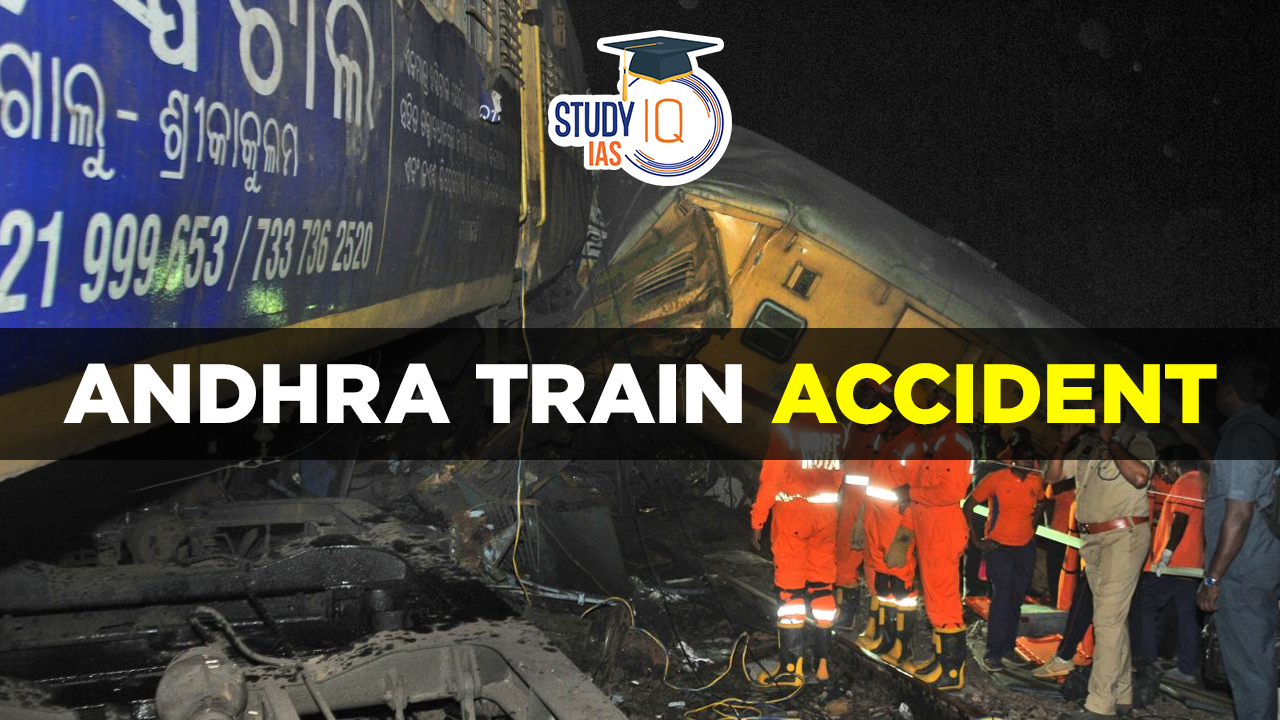Table of Contents
On Sunday, October 29 2023, a tragic train collision occurred in Andhra Pradesh between the Visakhapatnam-Palasa passenger train and the Visakhapatnam-Ragada passenger train, resulting in a derailment between the towns of Alamanda and Kantakapalle. This unfortunate incident claimed the lives of 14 individuals, and rescue operations are ongoing in the Vizianagaram district.
Andhra Train Accident
On October 29, a tragic train collision in Andhra Pradesh involving the Visakhapatnam-Palasa and Visakhapatnam-Ragada passenger trains led to a derailment between Alamanda and Kantakapalle towns. The devastating accident resulted in 14 casualties, with ongoing rescue efforts in Vizianagaram district. Prime Minister Narendra Modi has pledged financial aid, offering ₹2 lakh from the PM’s National Relief Fund to the families of each victim and ₹50,000 for the injured.
This Andhra Train Accident incident follows previous railway tragedies, including a triple-train collision in Odisha that claimed nearly 300 lives in June and a coach fire in southern India in August, which led to nine fatalities. Chief Minister Jagan Mohan Reddy is scheduled to visit the accident site and the injured in hospitals.
We’re now on WhatsApp. Click to Join
Train Accident in India
Railway accidents can be categorized based on their outcomes, such as head-on collisions, rear-end collisions, side collisions, derailments, fires, explosions, and more. They can also be classified by their underlying causes, which include factors like driver and signalman errors, mechanical failures of rolling stock, tracks, and bridges, vandalism, sabotage, terrorism, level crossing misuse and trespassing, natural occurrences like flooding and fog, risks associated with transporting dangerous goods, brake efficiency, and the adequacy of operating regulations.
Among India’s most tragic railway incidents, the 1981 Bihar train derailment stands out as the deadliest, claiming over 750 lives. It is followed by the 1995 Firozabad rail disaster (358 fatalities), the 2023 Odisha train collision (296 deaths), the 1999 Gaisal train disaster (285 casualties), the 1998 Khanna rail disaster (212 lives lost), the 2002 Rafiganj train wreck (200 fatalities), the 1964 Rameswaram cyclone-induced Pamban Bridge accident (resulting in over 150 deaths), and the 2010 Jnaneswari Express train derailment (which claimed 148 lives)
Read More: Railway Ecosystem in India
Biggest Train Accident in India
India’s deadliest train accident was the 1981 Bihar train derailment, which killed over 800 people. The train was carrying over 800 passengers when it derailed and fell into the Bagmati River between Mansi and Saharsa.
Other Deadly Train Accidents in India
- The 1995 Firozabad rail disaster, which killed 358 people
- The 2023 Odisha train collision, which killed 296 people
- The 1999 Gaisal train disaster, which killed 285 people
- The 1998 Khanna rail disaster, which killed 212 people
- The 2002 Rafiganj train wreck, which killed 200 people
Read More: Kavach Train Protection System
Biggest Train Accident in World
The 2004 Sri Lanka tsunami train wreck is the deadliest train disaster in history, with at least 1,700 fatalities. The accident occurred on December 26, 2004, when a crowded passenger train was destroyed by a tsunami that followed the 2004 Indian Ocean earthquake. The train, known as the Queen of the Sea, was travelling on a coastal railway in Sri Lanka.
Causes Train Accidents in India
Train accidents in India encompass various causes, including:
- Human Error: Often, accidents occur due to human mistakes, such as signalling errors, miscommunication, and other operational failures.
- Equipment Failure: Failures in rolling stock, tracks, or bridges can lead to accidents, potentially caused by poor maintenance, ageing infrastructure, vandalism, sabotage, or natural disasters.
- Sabotage: Malicious acts intended to harm railway operations can lead to tragic accidents.
- Infrastructure Defects: Issues with the railway infrastructure, stemming from poor maintenance, ageing components, vandalism, sabotage, or natural disasters, can result in accidents.
- Level Crossing Accidents: These happen when vehicles or pedestrians attempt to cross railway tracks at unauthorized or poorly managed crossings.
- Collisions: Collisions can result from signalling errors, miscommunication, or other operational failures.
Way Forward to Improve Railway Safety in India
- Enhanced Training and Monitoring: Invest in comprehensive training programs for railway staff to reduce human errors. Implement advanced monitoring systems to ensure adherence to safety protocols.
- Modernization and Maintenance: Prioritize the modernization of aging infrastructure, rolling stock, and tracks. Implement regular maintenance and upgrade schedules to prevent equipment failures.
- Security Measures: Strengthen security to prevent acts of sabotage and terrorism, including the use of advanced technology for surveillance and threat detection.
- Level Crossing Upgrades: Upgrade and manage level crossings to prevent accidents caused by unauthorized crossings. Implement stricter regulations and awareness campaigns.
- Improved Signaling and Communication: Enhance signaling systems and communication protocols to reduce collisions and miscommunications.
- Emergency Preparedness: Develop effective disaster response plans and drills for railway staff to handle fires, explosions, and other emergencies promptly.
- Regular Safety Audits: Conduct routine safety audits to identify and rectify infrastructure defects and vulnerabilities.
- Safety Awareness Campaigns: Increase public awareness about railway safety, level crossing rules, and the risks associated with railway trespassing.
- Use of Advanced Technology: Utilize modern technology for predictive maintenance, risk assessment, and real-time monitoring of trains and tracks.
- Government Investment: Encourage substantial government investment in railway safety to implement necessary reforms and upgrades.
Train Accidents in India UPSC
Train accidents in India can be classified by their outcomes, such as collisions, derailments, fires, and explosions, or by their underlying causes, including human errors, equipment failures, sabotage, infrastructure defects, level crossing accidents, and collisions. Tragic incidents like the 1981 Bihar train derailment and the 2023 Odisha train collision highlight the need for improved safety measures.
To enhance railway safety, India must focus on comprehensive staff training, modernization, security enhancements, level crossing upgrades, improved signaling and communication, disaster preparedness, safety audits, awareness campaigns, and advanced technology adoption. Significant government investments are crucial for implementing essential reforms and upgrades in the railway sector.























